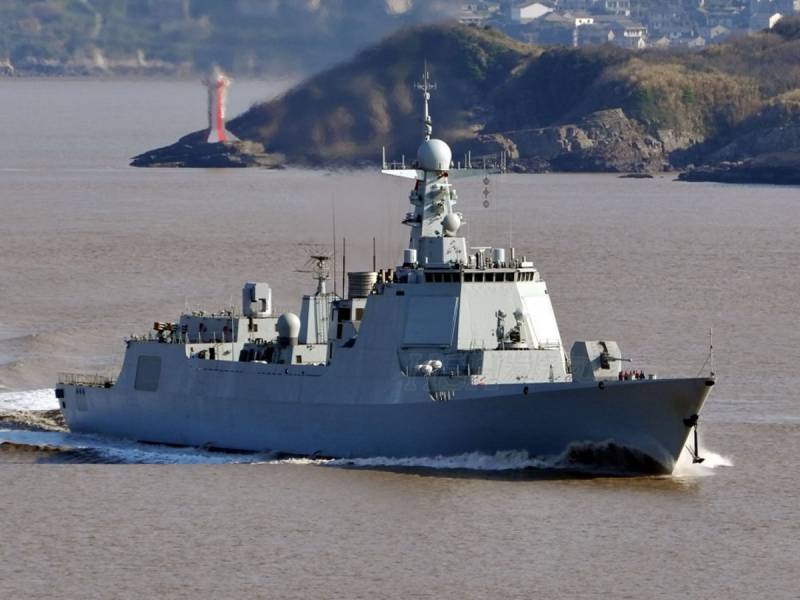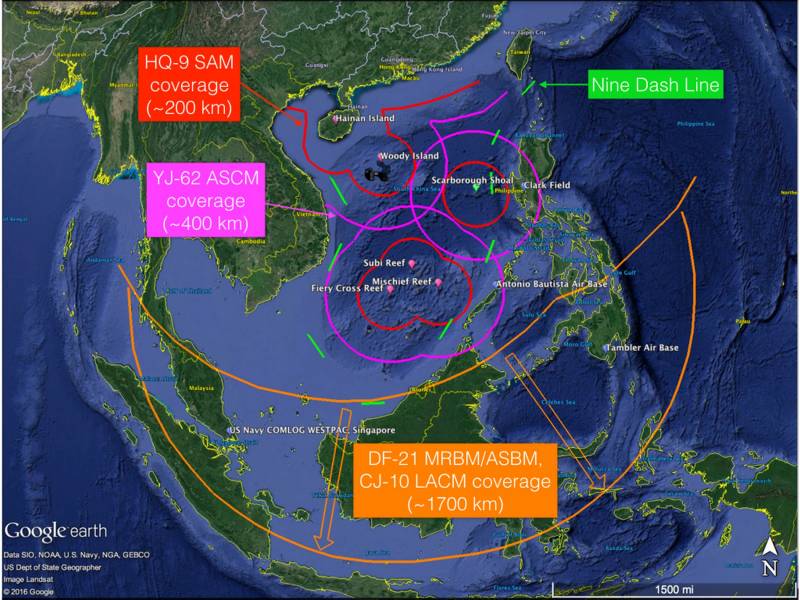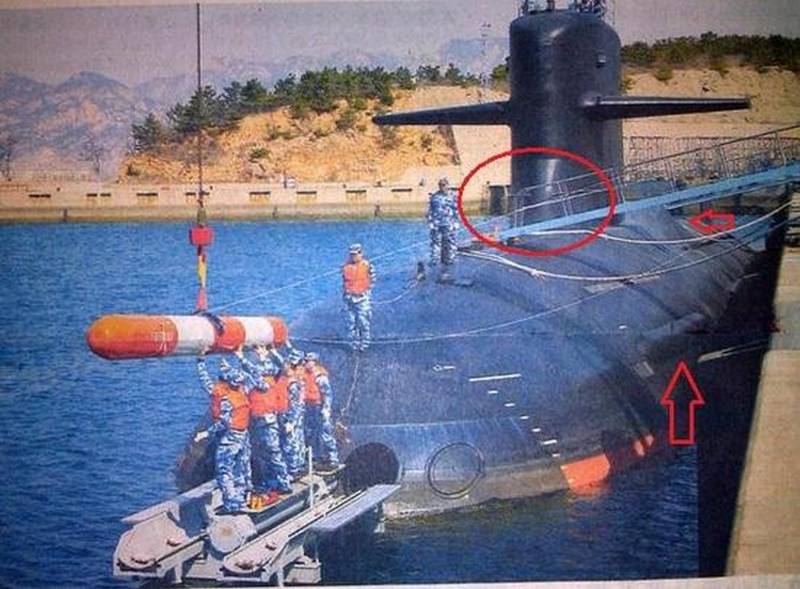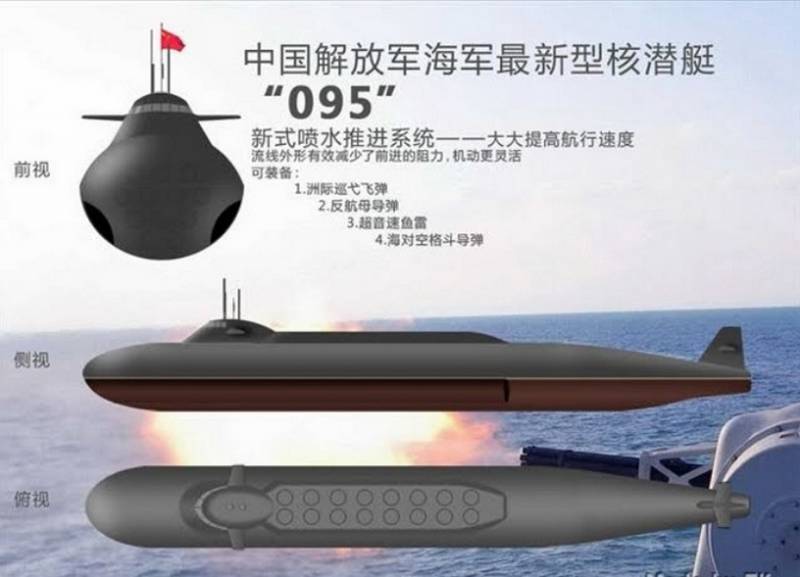PLA operation to expel the US Navy from the South China Sea. Biendong Area A2 / AD Details (part of 2)
As we can see, the air component of the anti-submarine component “A2 / AD”, based on Y-8Q patrol aircraft, is more than a reliable “screen” that limits the activities of American submarines within the “9-dotted line” (“cow tongue line”) . This line is the operational-strategic line that Beijing has developed to designate the exclusive economic zone of the Middle Kingdom in the South China Sea; It passes in the immediate vicinity of the territorial waters of Vietnam, Malaysia, Indonesia, Brunei, the Philippines and Taiwan, covering more than 80% of the waters of Bjendong. Criticism caused by this scenario from the Southeast states, in 2013, managed to reach the filing of a lawsuit against the International Arbitration Court against China by the leadership of the Philippines. However, to avoid the emergence of American fleet "At arm's length" from a strategically important defensive point - Hainan Island, as well as Hong Kong, the PRC leadership will continue to firmly defend its line regarding the borders of the "9-dotted line", including using the concept of restricting and denying access and maneuver " A2 / AD. "
Nevertheless, the formation of the “A2 / AD” border has not yet been completed. In addition to the Ticonderoga missile cruisers and the Arleigh Burke destroyers, carriers of the latest Tomahawk UGM-109E modification are also Ohio class strategic missile submarines converted into SSGNs (SSGN-726 Ohio, SSGN-727 Michigan) , SSGN-728 Florida, SSGN-729 Georgia). All 4 underwater “floating arsenals” are capable of releasing 616 UGM-109E “Tomahawk Block IV” along the southeast coast of China without even violating the “9-dotted line”, because the range of these modifications of the “Ax” reaches 1700 - 2400 km. It will be very difficult to fully repel such a massive missile strike using only the HQ-9, HQ-16, S-300/400 air defense systems and electronic warfare systems. aviation and AWACS aircraft. And even such unprecedented measures cannot guarantee 100% safety of the Chinese military-industrial and port infrastructure. Consequently, the PLA command focuses not so much on the destruction of the Tomahawk strategic cruise missiles as on the proactive disabling of their submarine carriers.
Ohio-class nuclear submarines are not included in the list of ultra-quiet submarines of the Ash, Sea Wolf, Virginia or Astute types, and therefore can be relatively easily detected using Y-8Q anti-submarine aircraft and Z-18 helicopters using RSL SQ-5 with unmanned underwater drones UUV Haiyan. The Type 052C Lanzhou and Type 52D Kunming destroyers will also be able to detect them, the sonar systems of which are represented by very modern in-hull active-passive SJD-8 / 9, developed on the basis of the French DUBV-23 complex. Considering that the regular French HAC has a detection range of sound-contrast and sound-emitting underwater objects of 40 km, its updated Chinese modifications SJD-8/9 are able to "hear and see" enemy underwater and surface assets at a distance of 60 to 100 km (in the second long-range acoustic illumination zone).
Also, the above destroyers use low-frequency GUS with a flexible long towed antenna (GPBA) ESS-1 (analogue DUBV-43 or Vignette-EM). Stations of this type are distinguished by excellent direction finding accuracy within 1 - 1,5º, as well as the detection range of various sound-emitting underwater targets. In particular, a submarine can be detected at a distance of 30 - 60 km (in the second near acoustic zone) in the deep sea and on the order of 15 - 20 km - in shallow water.
It all looks very serious, but neither the anti-submarine aircraft Y-8Q nor the surface combat ships of the Chinese Navy will be able to freely operate on sections of the Indo-Asian-Pacific theater of operations, which are far beyond the "9-dotted line" of the South China Sea: beyond due to the 5-fold superiority in the number of AUGs and the general ship composition, the US Navy will not allow the Chinese Y-8Q to patrol the waters of the Bay of Bengal, the Philippine Sea and the Sea of Sulawesi for the presence of impact versions of Ohio-type submarines, Four to six hundred TKR UGM-109E will be carried out from these borders in the event of an escalation of the conflict. Consequently, the only way out of the Chinese fleet is the active use of multi-purpose nuclear submarine cruisers with pronounced anti-ship and anti-submarine capabilities, which will hunt Ohio outside the “first chain” of the island states surrounding the Celestial Empire.
Multipurpose nuclear submarine cruisers of the 093 Shan project (also known as 09-III), designed on the basis of Russian torpedo-impact nuclear submarines of the 671РТМ (К) Shchuka project, have the necessary qualities. The sketch work on this project began at the beginning of the 90s, while the Chinese specialists received serious support from the Russian design bureau Rubin. Today, the new submarines have practically replaced the outdated and rather noisy MAPL of the Han 091 Ave. A very important detail is that the support from Rubin was provided in such fundamental and vital areas as the construction of the hull, the development of a CICS, an increase in the level of acoustic secrecy, as well as the creation of acoustic countermeasure complexes. As a result, starting from 2006, the technical level of the submarine component of the Chinese Navy began to move confidently towards world standards.
In particular, the level of acoustic secrecy "Shan" is somewhere between MAPL class "Los Angeles" and "Virginia", not reaching the level of "Ash," "Virginia", "Astute" and "Sea Wolfe." But this is a major achievement for China. The lack of an ideal acoustic stealth "Shan" is observed for many reasons, one of which is the presence of a standard propeller of an open architecture, while most modern SSGNs and SSBNs are equipped with water propellers; It also skipped information that Chinese engineers had been struggling for a long time with the problems of vibration reduction from a shock-absorbing platform on which a steam-turbine plant was placed together with circulation pumps, a turbo-gear unit and other equipment.
Nevertheless, the submarines of Shan Ave were very successful, and yet they were able to penetrate the anti-submarine lines of the American AUG on a “quiet run” and also approach the Ohio submarines at a distance of torpedo attack. The nomenclature of the percussion armament of the 093 “Shan” submarines is quite serious, and it is launched from 6 standard 533-mm torpedo tubes. The basis for the destruction of enemy submarines are anti-submarine torpedoes Yu-6 / 9 (developed on the basis of Soviet 211TT1; they have a maximum speed of the order of 115 km / h and a range of 50 km), electric torpedoes TEST-71M with a range of 20 km in 24 range of 82 km on 180, To defeat enemy surface ships can be used: YJ-85А long-range subsonic anti-ship missiles (400 km), YJ-500 advanced long-range supersonic anti-ship anti-ship missiles (with a range of about 1,5 - 1,7 km and speed in 18 - 300М at the final flight range), and heavier anti-ship supersonic missiles YJ-500. These missiles are multipurpose and are capable of striking enemy surface ships and coastal targets at a distance of 18 - 3 km. According to the construction and operation modes of the two-stage propulsion YJ-54 practically repeats Russian RCC type 900M35E "Caliber": midcourse filter operates compact turbojet dispersing RCC to 18 km / h, the final same 2850-kilometer section YJ-3200 rocket activates solid fuel stage providing speed in XNUMX - XNUMX km / h. At this stage, the rocket is able to perform intensive anti-aircraft maneuvers.
The YJ-85 and YJ-18 missiles allow the Shan multi-purpose atomic submarines to attack US naval ships in the Philippine Sea from a submerged position without going beyond the 9-dashed line and the first island chain, which eliminates the launch of anti-submarine missiles -torpedo complexes "VL-Asroc", and also allows you to avoid the detection of anti-aircraft US Navy.
The onboard radio-electronic and hydroacoustic equipment of the multi-purpose submarines of the 093 Ave. Shan is at a very high level and is quite comparable with the Russian and Western counterparts. In particular, due to equipping the submarine with an active-passive sonar complex with a distributed H / SQS-207 aperture (represented by 6 acoustic antenna arrays on the lateral surfaces of the hull and the main bow HAC), the possibility of all-field monitoring of underwater conditions in the second far-field acoustic illumination is realized. In the course of modernization, the submarine can get a stabilizing gondola of the UPV to accommodate a low-frequency flexible extended towed antenna, by analogy with the GPA Skat-2M on the submarines of 671TRTMK avenue. As you can see, the Chinese Navy has a decent underwater strike component capable of withstanding the US Navy AUG. The only drawback is only a small number of Shan-class submarines: according to official data, there are only 4 units in the submarine fleet.
Meanwhile, information has already appeared regarding the launch of the prototype of the upgraded Shan MAPL under the 093B project. The new submarine has significant differences from the first version of the 093 project: a water jet propulsion type is used, and for the missile "equipment" in the upper part of the body there is an impressive "rocket banquet" with the UNPU transport and launch containers, allowing for the use of larger rocket weapons, for example , strategic cruise missiles CJ-16 with a range of 10 km. Several images of a submarine appeared on the Chinese Internet at one time.
Separate attention should be paid to the development program of promising ultra low-noise multipurpose submarine Type 95. Based on the Chinese sketches, we can talk about the unique indicators of the acoustic secrecy of the new submarine. Here we see the original design of a water jet propulsion unit with an in-shell impeller (multi-propeller propeller); instead of the standard annular water intake, there are 2 embedded water inlets in the rear part of the submarine hull. This will reduce its total noise by dozens of times. On the upper surface of the hull, you can see the familiar mine "rocket banquet" with a UHF on 16 guides with a diameter of about 1,5 - 1,8, in which up to 3 x 533 - 670 anti-missile tactical missiles can be placed. The total arsenal of one “rocket banquet” alone can be 48 units, and there are also 8 533-mm torpedo tubes. The sounded depth of the Bohai brainchild does not shine, reaching 500 m, but considering the speed at the 33 node, everything is more than positive.
It should be noted that in the surface mode, the submarine will be quite difficult to detect with radar tools from a distance of more than 100 - 150 km, since composite / radio absorbing materials are widely used in the hull and cabin design, and the cutting house itself has sloping sides and is smaller in 2 than the dimensions classic angular cuttings (the so-called "stealth cabin").
The descent from the stocks of the Bohai shipyard of the first submarine, the Type 095, will truly be a turning point in the formation of the Chinese submarine fleet, which will significantly expand the existing A2 / AD zone from the South China Sea alone to remote sites in the Indian and Pacific Ocean. The underwater component of the current zone of restriction and prohibition of access and maneuver of the PRC will be very successfully maintained by anti-submarine aviation from Hainan Island, four MAPLs of 093 A / V Shan and more than 15 ultra low-noise diesel-electric anaerobic submarines (with an air-independent power plant ) Type 041 "Yuan". The latter can be at a depth of 300 m for 20 - 25 days (without the need for ascent), which turns all US plans to “oppress” China in Southeast Asia into a deliberately losing game.
Information sources:
http://forum.militaryparitet.com/viewtopic.php?id=17391
http://forum.militaryparitet.com/viewtopic.php?id=17402
http://bastion-karpenko.ru/093-2/
http://raigap.livejournal.com/333768.html




Information